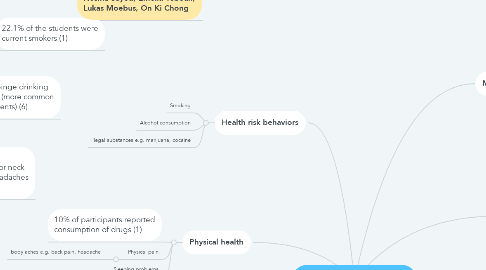Students' health issues
af Sherry Chong

1. Health risk behaviors
1.1. Smoking
1.2. Alcohol consumption
1.3. Illegal substances e.g. marijuana, cocaine
2. Physical health
2.1. 10% of participants reported consumption of drugs (1)
2.2. Physical pain
2.2.1. body aches e.g. back pain, headache
2.3. Sleeping problems
3. Physical activity
4. Academic
4.1. Presentism/Absenteeism
4.2. Poor time management, Procrastination
4.3. Violation of academic honesty e.g. homework copying, cheating
5. 75% of interviewed students admitted to different kinds of academic dishonesty over the past 6 months (5)
6. 42.7% of participants reported being distracted from students (Female > Male) (6)
7. 40% exercised less than once per week (1); only 26.7% reported being physically active acc. to WHO guidelines (6)
8. At least half participants reported shoulder, back or neck pain; 37.2% reported headaches (>1 times/month) (6)
9. 31.1% reported binge drinking >=1 time/ month (more common among male students) (6)
10. 18.5% of interviewed students smoked (6)
11. 42.8% had impaired sleep quality; other sleep problems e.g. intermittent sleep, insomnia, sleepiness during daytime (2)
12. 22.1% of the students were current smokers (1)
13. Group members: Nesma Sayed, Emelia Yeboah, Lukas Moebus, On Ki Chong
14. Mental health
14.1. High perceived stress
14.2. Depression
14.3. General anxiety
14.4. Burnout, loss of meaning
14.5. Adjustment, adaptation problems
14.6. Panic attack
15. Nutrition
15.1. Poor selection of food choices
15.1.1. Underweight
15.1.2. less attention to healthy food
15.2. Eating disorders
15.2.1. distorted body images
15.2.2. Overweight
16. Interpersonal
16.1. Relationship problems
16.2. Family problems
17. References: 1. Helmer SM, Krämer A, Mikolajczyk RT. Health-related locus of control and health behaviour among university students in North Rhine Westphalia, Germany. BMC research notes. 2012;5(1):703. 2. Schlarb AA, Claßen M, Grünwald J, Vögele C. Sleep disturbances and mental strain in university students: results from an online survey in Luxembourg and Germany. International journal of mental health systems. 2017;11(1):24. 3. Chan JK, Farrer LM, Gulliver A, Bennett K, Griffiths KM. University students’ views on the perceived benefits and drawbacks of seeking help for mental health problems on the Internet: a qualitative study. JMIR human factors. 2016;3(1):e3. 4. Grobe TG, Steinmann S, Szecsenyi J. Arztreport 2018 Schriftenreihe zur Gesundheitsanalyse [Internet]. Barmer; 2018 [cited 2019 Oct 22]. Available from: https://www.barmer.de/blob/144368/08f7b513fdb6f06703c6e9765ee9375f/data/dl-barmer-arztreport-2018.pdf 5. Grove J.Procrastination and Bogus Excuses [Internet]. Inside Higher Ed 2015 [cited 2019 Oct 22]. Available from: https://www.insidehighered.com/news/2015/06/26/study-links-procrastination-and-bogus-excuses-german-university-students 6. Grützmacher J, Gusy B, Lesener T, Sudheimer S, Willige J. Gesundheit Studierender in Deutschland 2017. Ein Kooperationsprojekt zwischen dem Deutschen Zentrum für Hochschul-und Wissenschaftsforschung, der Freien Universität Berlin und der Techniker Krankenkasse. Hannover. 2018.
18. Subjective social status
18.1. Perceived lower status in the society
19. 32.5% of participants perceived themselves on the lower places of social ladder (6)
20. 24.4% reported initial symptom of exhaustion/fatigue; 22.9% reported a loss of meaning in terms of their study (6)
21. 37.1% females & 46% males did not have a stable relationship/marriage with a partner (6)
22. Female students generally reported more depressive/anxiety related symptoms (2;6)
23. 17.5% of participants were overweight; 5 % were underweight; students with low locus of control had problems in food selection (1,3)
24. Students experience changes in their educational system(4)
25. Insurance report documented 13.7% of in-patient treatment due to mental disorders; increased diagnosed rate for mental disorders e.g. depression, affective disorders in 2016 (a double of that in 2005) (4)
26. 25.5% reported elevated depression, 13.3% had social phobia symptoms and 45% indicated elevated stress levels (2)


